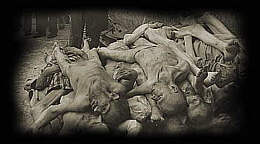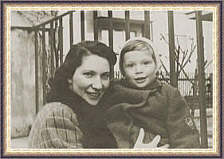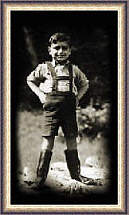







![]()

Tomas Kulka, a Jewish boy shown here at age three, was the son of Elsa and Robert Kulka, who were married in 1933 in Brno in Moravia and moved to Olomouc, where Tomas was born. The city Olomouc is, after Prague, the second most historical city in The Czech Republic, the gateway to the Jeseniky mountains. A city, which is referred to as The Pearl on the Green and The Heart of the Haná Region. A perfect idyll.
Following Elsa's father's death in 1937, the family moved to Brno where they took over the family shipping company.
Just before Tomas' fifth birthday the Nazis occupied Moravia. Because Tomas was Jewish, he was not allowed to attend school. On March 31, 1942 Tomas and his family were sent to the KZ camp Theresienstadt. In May, he and his maternal grandmother were deported to Sobibor, where they were gassed upon arrival. Tomas was two weeks short of his eighth birthday. That same year his parents died in the Ossova labor camp in Ukraine.

The deathcamp Sobibor operated from May 1942 until October 1943 for only one purpose: to kill as many Jews as quickly as possible. Sobibor`s gas chambers killed an approximate total of 260,000 Jews. Transports arrived by rail, and prisoners were taken immediately toward the gas chambers. Only 47 managed to survive Sobibor and give evidence of the existence of the death camp.
Before the war ended the killing installations at Sobibor were destroyed and the area planted over with trees ...
![]()

Redlich Goldstein, another member of the Jewish community in Olomouc, poses here with her son, Michael. Before the war Bohus and Redlich Goldstein led a happy life in Olomouc, highlighted by the births of their two children, Eva and Michael. Bohus worked for the Prague autoworks.
The Goldstein family's feelings of security collapsed, however, when Germany invaded their country, and the brutality of the Nazis accelerated with murder, violence and terror. The family was herded into a Jewish Ghetto and then torn apart.
All four perished during the Holocaust ...
![]()

Jacqueline Morgenstern, born to Suzanne and Karl Morgenstern in 1932, led a happy life in Paris, France, with her family. She attended school and her father and uncle owned a beauty shop in central Paris.
But when the Nazis invaded France it was all over. In 1944 Jacqueline and her parents were crowded into cattle cars with hundreds of Jews to be deported to the Auschwitz deathcamp. Jacqueline and her mother Suzanne went to the women's work camp, where food rations were meager. Suzanne gave Jacqueline most of her food, so she herself became malnourished and ill. The Nazis sent her to the gas chambers ..
After her mother's death, Jacqueline was sent to a special children's barrack where the children were being held for later bogus medical experiments. In November 1944 20 Jewish children, ten boys and ten girls, among them Jacqueline, were brought from Auschwitz to the concentration camp of Neuengamme, just outside Hamburg. The youngsters, aged between 5 and 12 years old, came from all over Europe.

Children from Bullenhuser Damm
Now they were to be human guinea-pigs in a series of medical experiments conducted by the SS doctor Kurt Heissmeyer. Dr. Heissmeyer removed the children's lymph glands for analysis, and he injected living tuberculosis bacteria in their veins and directly into their lungs to determine if they had any natural immunities to tuberculosis.They were carefully observed, examined and photographed as the disease progressed. The condition of all the children deteriorated very rapidly and they became extremely ill.
On April 20th, 1945, the day on which Adolf Hitler was celebrating his fifty-sixth birthday and just a few days before the war ended, Heissmeyer and SS-Obersturmführer Arnold Strippel decided to kill the children in an effort to hide evidence of the experiments from the approaching Allied forces.
|
Bullenhuser Damm School |
|
To conceal all traces the SS transported the children to the former Bullenhuser Damm School, which had been used as a satellite camp since October 1944. They were immediately taken to the basement and ordered to undress. An SS officer later reported: "They sat down on the benches all around and were cheerful and happy that they had been for once allowed out of Neuengamme. The children were completely unsuspecting."
The children were told that they had to be vaccinated against typhoid fever before their return journey. Then they were injected with morphine. They were hanged from hooks on the wall, but the SS men found it difficult to kill the mutilated children. The first child to be strung up was so light - due to disease and malnutrition - that the rope wouldn’t strangle him. SS untersturmführer Frahm had to use all of his own weight to tighten the noose. Then he hanged the others, two at a time, from different hooks. 'Just like pictures on the wall', he would recall later. He added that none of the children had cried.
At five o' clock in the morning on April 21th, 1945, the Nazis had finished with their work and drank hard-earned coffee ...
![]()

Jacques Benguigui was born on April 13, 1931, in Oran, Algeria. Seeking to improve the chances for a better life for her children, Mrs. Benguigui moved the family to Marseilles, France, shortly before WW2. On July 31, 1943, the family was betrayed to the Nazis by some French collaborators. Jacques' mother was deported to Auschwitz in Poland, where she was abused for ghastly medical experiments.
Jacques and his two younger brothers, Richard, six years old, and Jean-Claude, who was five, were sent to be sheltered in the Children's home in Izieu, a little village east of Lyon. They were safe until the raid of April 6, 1944, by the Lyon Gestapo, headed by Klaus Barbie.
As they all settled down that day in the refectory to drink hot chocolate, three vehicles pulled up in front of the home. Klaus Barbie and the Nazis entered the home and forcibly removed the forty four children and their seven supervisors, throwing the crying and terrified children on to the trucks like sacks of potatoes.

The children of Izieu
As a witness later recalled:'I was on my way down the stairs when my sister shouted to me: it's the Germans, save yourself! I jumped out the window. I hid myself in a bush in the garden. I heard the cries of the children that were being kidnapped and I heard the shouts of the Nazis who were carrying them away..'
The children were deported to Auschwitz on April 13, 1944, Jacques's 13th birthday, one of the last transports from France. The children were murdered in the gas chambers of Auschwitz, May, 1944. One survivor of Auschwitz later recalled:
"I asked myself where were the children who arrived with us? In the camp there wasn't a single child to be seen. Then those who had been there for a while informed us of the reality. 'You see that chimney, the one smoke never stops coming out of . .. you smell that odor of burned flesh ... ?"
Of the forty-four children kidnapped by the Nazis in Izieu, not a single one survived. Of the supervisors there was one sole survivor, twenty-seven year old Lea Feldblum.
While in Izieu Jacques Benguigui wrote a letter to his mother, who survived the Holocaust:
"O Maman, my dear Maman, I know how much you've suffered on my account and on this happy occasion of Mother's Day I send you from afar my best wishes from the bottom of my little heart. So far from you, darling Maman, I've done everything I could to make you happy: when you've sent packages, I've shared them with the children who have no parents. Maman, my dear Maman, I leave you with hugs and kisses. Your son who adores you. Jacques."
![]()

Eight-year-old Georges Halpern, born Oct. 30, 1935 in Vienna, was also being sheltered with the other children in The Children's home in Izieu in the hope that the Nazi Gestapo would not find them. The Children's Home was a perfect idyll and the Jewish children led a happy life with plenty of time for playing, drawing and painting. On the morning of April 6, 1944, it was all over ..
Gorges Halpern was one of the 1.5 million children killed during the horrors of the Holocaust. After the war this letter was found - the little boy wrote to his mother:
"Chere Maman, I send you 10000000000 kisses your son who loves you very much. There are big mountains and the village is very pretty. There are a lot of farms and we look for blackberries and raspberries and white mulberries. I hug you with all my heart. Georgy."

Sketches made by the Izieu Children
After the Nazi raid Klaus Barbie sent a telex to Gestapo headquarters in Paris declaring that the children's colony at Izieu had been removed and arrangements made for the deportation of its residents. The full text, which contains mistakes about the children's ages and apparently counted three of the oldest children among the adults arrested, reads:
"This
morning, the Jewish children's home, Children's Colony, at Izieu has been
removed. 41 children in all, aged 3 to 13, have been captured. Beyond that, the
arrest of all the Jewish personnel has taken place, namely 10 individuals, among
them 5 women. It was not possible to secure any money or other valuables.
Transportation to Drancy will take place on 4/7/44. Signed Klaus Barbie."




|
Full statistics for the tragic fate of children who died during the Holocaust will never be known. Estimates range as high as 1.5 million murdered children. This figure includes more than 1.2 million Jewish children, tens of thousands of Gypsy children and thousands of institutionalized handicapped children. Plucked from their homes and stripped of their childhoods, the children had witnessed the murder of parents, siblings, and relatives. They lived and died during the dark years of the Holocaust and were victims of the Nazi regime ... |
sources:
The United States Holocaust Memorial Museum
The Simon Wiesenthal Center - www.wiesenthal.com
Musee Memorial des Enfants d’Izieu - www.izieu.alma.fr
The Children of Izieu: A Human Tragedy, by Serge Klarsfeld
Photographs
from French Children of the Holocaust A Memorial by Serge Klarsfeld
www.auschwitz.dk Louis Bülow Privacy. ©2010-12.